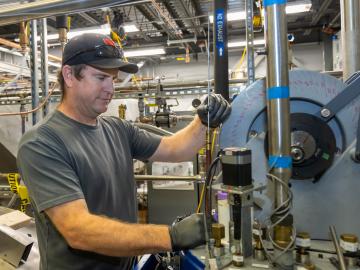Filter News
Area of Research
News Type
News Topics
- (-) Bioenergy (16)
- (-) Biology (20)
- (-) Frontier (2)
- (-) Machine Learning (4)
- (-) Mercury (4)
- (-) Physics (17)
- 3-D Printing/Advanced Manufacturing (12)
- Advanced Reactors (2)
- Artificial Intelligence (3)
- Big Data (5)
- Biomedical (8)
- Biotechnology (3)
- Buildings (9)
- Chemical Sciences (8)
- Clean Water (6)
- Climate Change (14)
- Composites (2)
- Computer Science (12)
- Coronavirus (6)
- Critical Materials (1)
- Cybersecurity (6)
- Decarbonization (14)
- Energy Storage (14)
- Environment (36)
- Exascale Computing (2)
- Fusion (7)
- Grid (7)
- High-Performance Computing (8)
- Hydropower (2)
- Isotopes (8)
- ITER (1)
- Materials (7)
- Materials Science (12)
- Mathematics (3)
- Microscopy (9)
- Nanotechnology (6)
- National Security (15)
- Net Zero (2)
- Neutron Science (8)
- Nuclear Energy (14)
- Polymers (5)
- Quantum Computing (1)
- Quantum Science (2)
- Security (6)
- Simulation (4)
- Summit (2)
- Sustainable Energy (13)
- Transportation (12)
Media Contacts

Associate Technician Sean Hollander is the keeper of the Fundamental Neutron Physics Beamline, which is operated by the Physics Division at the Spallation Neutron Source at ORNL, where scientists use neutrons to study all manner of matter.

Alyssa Carrell started her science career studying the tallest inhabitants in the forest, but today is focused on some of its smallest — the microbial organisms that play an outsized role in plant health.

Ilenne Del Valle is merging her expertise in synthetic biology and environmental science to develop new technologies to help scientists better understand and engineer ecosystems for climate resilience.


Walters is working with a team of geographers, linguists, economists, data scientists and software engineers to apply cultural knowledge and patterns to open-source data in an effort to document and report patterns of human movement through previously unstudied spaces.

Madhavi Martin brings a physicist’s tools and perspective to biological and environmental research at the Department of Energy’s Oak Ridge National Laboratory, supporting advances in bioenergy, soil carbon storage and environmental monitoring, and even helping solve a murder mystery.

After completing a bachelor’s degree in biology, Toya Beiswenger didn’t intend to go into forensics. But almost two decades later, the nuclear security scientist at ORNL has found a way to appreciate the art of nuclear forensics.

When reading the novel Jurassic Park as a teenager, Jerry Parks found the passages about gene sequencing and supercomputers fascinating, but never imagined he might someday pursue such futuristic-sounding science.

At the National Center for Computational Sciences, Ashley Barker enjoys one of the least complicated–sounding job titles at ORNL: section head of operations. But within that seemingly ordinary designation lurks a multitude of demanding roles as she oversees the complete user experience for NCCS computer systems.

Andrea Delgado is looking for elementary particles that seem so abstract, there appears to be no obvious short-term benefit to her research.




